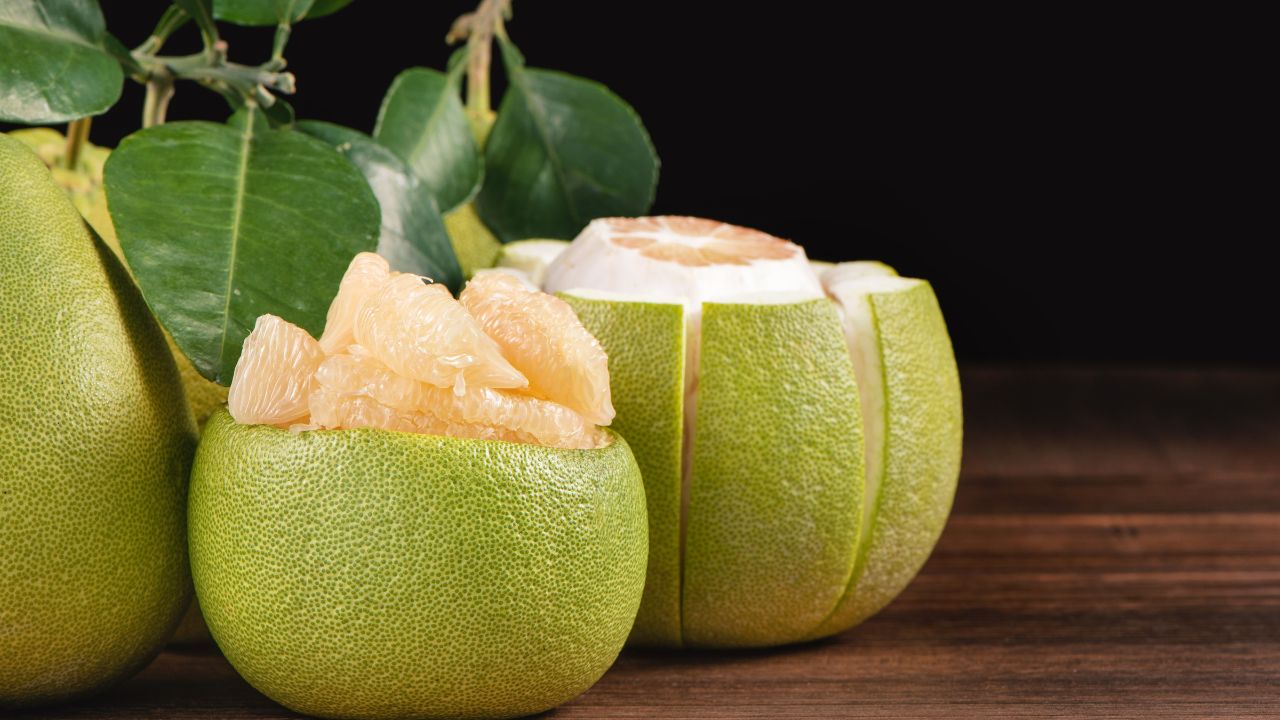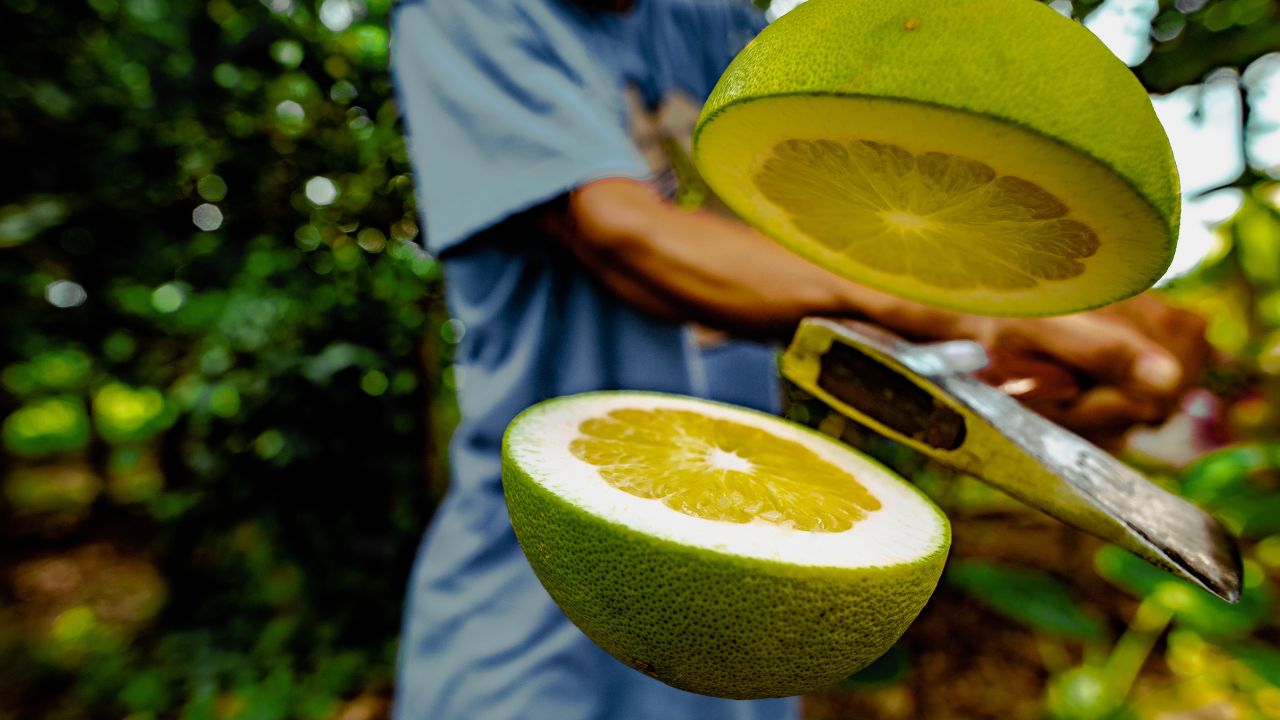Have you ever had a huge citrus fruit that wasn’t actually an orange? You were most likely snacking on a pomelo.
Pomelo fruits are the largest citrus fruits on the market and are prevalent in several Asian dishes. However, there are many people who don’t know the taste of this massive citrus fruit.

If you are one of them, you’ve come to the right place as in this article we will talk about what pomelo tastes like!
It has a sour and tart flavor that is comparable to that of grapefruits but not as powerful, so if you enjoy eating grapefruits you will definitely enjoy eating pomelos!
What Exactly Is Pomelo Fruit?
Pomelo fruit commonly referred to just as pomelo, is a citrus fruit indigenous to Southeast Asia. They are the largest citrus fruits on the planet and are species of the Rutaceae family.
It might sound crazy to most of us, but a single pomelo’s weight can even be 10 pounds!
Pomelo trees are growing in abundance in tropical and subtropical geographic areas. With the fruit itself often weighing 10 pounds, you can imagine how massive the trees are.
Often reaching 50 feet in height, they are easily identifiable. The fruit is very discernible too, but not only thanks to its size.
It has the shape of a teardrop and a thick yellowish and greenish rind with a fleshy interior whose color is usually white or pinkish.
Pomelo fruits are typically consumed raw, but they may also be found in smoothies, cocktails, as well as savory recipes.
There are different types of pomelos, with the following being the most common:
- White Pomelos, a type from Israel.
- Red Pomelos, which are native to Malaysia.
- Pink Pomelos
- Tahitian Pomelos
Do you remember how we mentioned in the beginning that the pomelos are closely linked to grapefruits?
To be more precise, In fact, grapefruits are a cross between pomelos and sweet oranges. So, it is no surprise that these two fruits’ tastes are comparable.
How Do Pomelo Fruits Taste?
A pomelo is neither as tart nor as sweet as an orange or grapefruit. They are perfectly balanced, and they are both sweet and sour at the same time.
Pomelos are also referred to as pummelos, Chinese grapefruits, Jabong, and shaddocks. Yet, irrespective of the name you are using for this citrus fruit, there is one thing that is certain: it tastes amazing!
The flavor of pomelos can vary from really sweet to tart, but that depends on whether it is white, red, or any other type.
With every pomelo type tasting either a bit sweeter or a bit sour, you can now understand why they are said to taste something between oranges and grapefruits.
Those who have tried a pomelo before generally agree that the pink varieties are sweeter and more flavorful than the white ones.
However, the color is not the only thing that defines a pomelo’s taste. The area where they are grown also plays a big part in this.
Tahitian pomelos, for example, are regarded as the best when it comes to flavor. They have a very sweet and succulent flavor and plenty of seeds. Red pomelos, on the contrary, are tangier and tarter when it comes to their flavor.
Overall, pomelo fruits are the perfect pairing of sweet and sour tastes that are delightful and extraordinary. But it seems that in certain varieties, one flavor overpowers the other.
Either way, we should make clear that in no way are pomelos more bitter than grapefruit, regardless of which one of them – white, red, Tahitian, or other – you are tasting.
The Health Benefits Of Pomelo Fruits
Pomelo fruits contain a wide range of vitamins, minerals, and antioxidants, making them a nutritious part of people’s diets.
In particular, they are rich in vitamin C, and high in dietary fiber, copper, and potassium.
They are also known to promote the growth of beneficial bacteria in the gut, avert cell injury, and, thanks to the potassium content, maintain the right blood pressure and fluid consistency.
A single pomelo fruit contains 6 grams of fiber. We should aim for a minimum of 25 grams of dietary fiber per day, so pomelos are a wonderful way to meet that goal.

To be more precise, pomelos are high in insoluble fiber, which adds bulk to our feces and helps us avoid feeling and being constipated.
In addition to that, pomelos might also boost cardiovascular health by lowering triglyceride and cholesterol levels, two blood fatty acids related to cardiovascular diseases.
Finally, these fruits may have anti-aging properties owing to their increased number of powerful antioxidants, while they also minimize skin damage, allowing us to look younger.
How To Consume Pomelo Fruits
The best way to consume pomelos is certainly in their raw form, without cooking them or turning them into juice.
The aromatic and tart juices of the flesh will be like little explosions to your palate that will happen every single time you take another bite of that pomelo.
Nevertheless, if you love this fruit so much that you want to include it in every meal of yours and not simply snack on it, you can easily cook it and add it to your favorite recipes.
Pomelos are incorporated in a broad range of dishes, particularly Asian-inspired ones.
So, next time you are making a salad, soup, or stir-fry, try adding it to the recipe or replacing it in recipes where grapefruits and oranges are used.
The fruit’s sweet taste will offset the savory taste provided by the rest of the ingredients. And if you want the freshness of pomelos in your dessert, don’t think twice before making a pomelo pavlova!
Below is some advice for cooking with pomelos:
- First, you need to peel the pomelos and remove the top and bottom to score the flesh. Be careful, though, as you don’t want to pierce the rind.
- After you’ve peeled it, you can chop the flesh in any way you want. If you are using other vegetables and fruit in the recipe, try to keep them all in the same size.
- Cook the pomelos in water with lemon juice, lime juice, or vinegar, to prevent them from turning brown.
- Pomelo fruits can be prepared in a variety of cooking methods, including steaming, boiling, and frying.
- To avoid overcooking and making the pomelo pieces mushy, start cooking them once the cooking process has ended.
The Bottom Line
Pomelo fruits are the perfect balance between a sweet and sour taste, which is why they are ideal for both savory and sweet recipes. Their nutritional benefits are also exceptional, so make sure you add them to your diet!
- 15 Traditional Greek Breads - July 31, 2023
- 30 Delicious And Gluten-Free Cookie Recipes - July 29, 2023
- 30 Of The Best European Desserts - July 29, 2023
